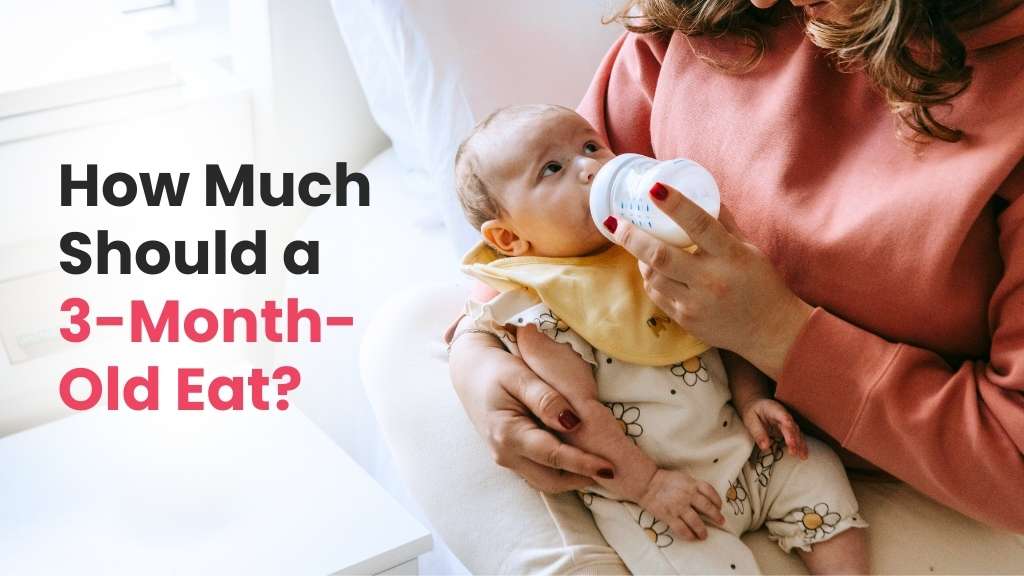
Table of Contents
During the next few months with your 3-month-old baby, you’ll be getting used to being a parent. You’ll create daily routines and spend lots of quality time with your adorable baby. While some things might still be a bit challenging, you might start feeling more confident as new parents compared to the earlier months. One such question is how much should a 3 month old eat?
As your baby continues to grow and reach new milestones, we’re here to guide you through some of the exciting developments that happen at this age. We’ll answer common questions you might have. So, even though you might be a bit sleep-deprived, remember that you’re doing a great job! If you’re still unsure, keep reading to learn more.
How Much Breastmilk Should A 3 Month Old Eat?
When your baby is three months old, their feeding routine might change compared to when they were a newborn. It depends on whether they’re getting breast milk, formula, or a mix of both. Typically, babies of this age can drink more milk during each feeding than they did in the past two months. So, they might need fewer feedings, usually around 6 to 8 times a day.
A baby who’s 3 months old usually drinks around 4 to 6 ounces of formula or breast milk every 3 to 4 hours. If you’re using a baby formula to feed your little one, you might want to consider choosing one that includes “2′-FL HMO.” But remember, every baby is unique, so some might want a little more or a little less than this amount.
Sure, when babies are growing fast, they might want to eat a lot in a short time. This is called cluster feeding, and it’s especially common in babies who drink breast milk. During these growth spurts, babies want to nurse more often, and this helps their parent’s body make more milk to keep up with the baby’s growing hunger.
Remember, whether your baby is breastfed or bottle-fed, they become better at eating as they grow. So, breastfed babies might need less time at the breast, and bottle-fed babies might become impatient or start squeezing the bottle nipple. If this happens, you might have to buy different bottle nipples.
Babies are unique, so there’s no one-rule-fits-all rule, but here’s a general idea: your baby typically needs around 90 calories for every kilogram they weigh, or 40 calories per pound of their weight each day. How much should a 3-month-old eat during the day can also depend on how much they sleep at night. If they sleep through some nighttime feeds, they might need to eat more or more often during the day compared to a baby who wakes up every three hours.
Also read: When Do Babies Sleep Through The Night?
Now, when it comes to giving them solid foods, it might be tempting, but it’s best to wait until your baby is about 6 months old.
If you’re worried your baby isn’t eating enough, you can check their diapers. If your baby has at least 6 wet diapers and several dirty ones in a day, that’s usually a good sign they’re getting enough milk. But if they’re growing well and not having a lot of dirty diapers, there’s no need to panic.
Worries About Overfeeding?
How much breastmilk should a 3-month-old eat before they’re overfed? Babies are usually pretty good at eating just the right amount for their little tummies, but sometimes they can end up eating more than they need. If your baby is drinking from a bottle, it might be more prone to overeating compared to a baby who breastfeeds because it’s easier to get milk from a bottle.
If your baby gets too much food in one go, they might feel some tummy discomfort, get gassy, or even spit up. That’s why it’s a good idea to start with a smaller amount when feeding your baby because you can always give them more if they still seem hungry.
This approach also lets your baby decide if they’re still hungry or not. If they show signs that they want more, go ahead and give them more. It’s important to remember not to make them eat if they’ve stopped being interested, and you shouldn’t withhold food if your baby is genuinely hungry.
So, How Much Should a 3 Month Old Eat?
When your baby was a newborn, the American Academy of Pediatrics (AAP) suggested figuring out how much they should eat based on their weight. For every pound your baby weighed, you’d give them about 2.5 ounces of formula or breast milk. Nursing moms were advised to breastfeed every 2 to 3 hours for around 15 minutes on each breast. It was also important to pay attention to your baby’s cues for hunger and fullness.
Now that your baby is a bit older, you don’t need to do those calculations unless your baby is underweight or isn’t gaining weight. Your main goal now is to make sure your baby eats regularly and gets the right amount of formula or breast milk.
As babies develop, they may begin to feed less frequently since they become more efficient eaters, consuming larger amounts of milk or formula during each feeding. Typically, they’ll feed every 3 to 4 hours. However, if your baby is breastfed, they might need more frequent feedings initially because breast milk is digested faster than formula.
You might worry about missing nighttime feedings, especially if you were used to feeding your baby around the clock. But if your baby sleeps for 5 to 6 hours at night, you usually don’t need to wake them up to eat, unless their doctor says otherwise.
For babies who breastfeed, try to feed them every 3 to 4 hours, spending around 15 minutes on each breast. If your baby is on formula, they should also eat every 3 to 4 hours, and the amount typically ranges from 4 to 8 ounces, depending on how old they are.
Here are some general guidelines for how much your baby should eat based on their age. Keep in mind that these are just rough estimates, and every baby is different, with their needs changing from day to day. It’s a good idea to discuss these changes with your baby’s doctor.
How Much Should a 6 to 3-month-old Eat? | |||
Age (in months) | Formula (in ounces) | Expressed Milk (in ounces) | Breastfeeding (minutes per breast) |
6 | 6 to 8 | 5 to 8 | 15 |
5 | 4 to 8 | 4 to 6 | 15 |
4 | 4 to 6 | 4 to 6 | 15 |
3 | 4 to 5 | 3 to 4 | 15 |
Sample Feeding Schedule For You
Here’s a simpler way to explain the feeding schedules for a 3-month-old baby:
Remember, every baby is different, but this can give you an idea of how much and how often a typical 3-month-old baby might eat. It’s important to talk to your doctor to create a feeding plan that’s just right for your baby.
How Much Should A 3 Month Old Eat: Formula Edition
– At 6 a.m., give them 4 ounces of formula.
– At 9 a.m., give them 4 ounces of formula.
– At 12 p.m., give them 4 ounces of formula.
– At 3 p.m., give them 4 ounces of formula.
– At 6 p.m., give them 4 ounces of formula.
– At 9 p.m., give them 4 ounces of formula.
– At 1 a.m., give them 4 ounces of formula.
How Much Should A 3 Month Old Eat: Formula + Breastmilk Edition
– At 6 a.m., breastfeed for 15 minutes on each breast or give 4 ounces of formula or expressed breast milk.
– At 9 a.m., do the same as the morning feeding.
– At 12 p.m., do the same again.
– At 3 p.m., do the same.
– At 6 p.m., breastfeed for 15 minutes on each breast.
– At 9 p.m., breastfeed for 15 minutes on each breast.
– At 1 a.m., give 4 ounces of formula or expressed breast milk.
How Much Should A 3 Month Old Eat: Breastmilk Edition
– At 5 a.m., breastfeed on both breasts.
– At 7 a.m., breastfeed on both breasts.
– At 10 a.m., breastfeed on both breasts.
– At 12 p.m., breastfeed on both breasts.
– At 3 p.m., breastfeed on both breasts.
– At 6 p.m., breastfeed on both breasts.
– At 9 p.m., breastfeed on both breasts.
– At 1 a.m., breastfeed on both breasts.
These are just examples to help you get started, but your baby’s needs may vary. It’s always a good idea to consult with your pediatrician for a feeding plan tailored to your baby’s specific requirements.
A Note For Our Readers
At this stage, you’re probably getting the hang of feeding your baby regularly, and things might not be as hectic as when you first brought them home from the hospital. It’s important to feed your baby when they’re hungry and stop when they’re full.
At this age, it’s a good idea to pay attention to your baby’s signals for hunger and fullness and let them decide how much they want to eat. This helps them learn about their bodies and can have a lasting impact on their relationship with food and their body as they grow up.
Keep up with your baby’s well-check appointments, and be sure to watch for signs that they’re content after a feeding. If you have any questions about breastfeeding, if you’re experiencing any pain or discomfort, or if you have concerns about how your baby is latching on, don’t hesitate to get in touch with a certified lactation consultant. They can provide valuable guidance and support.
FAQs:
1. How many Oz should a 3-month-old eat?
2. How much should a 3-month-old eat chart?
Age and Feeding Information
| Age | Time between Feedings | Ounces per Feeding |
|---|---|---|
| 0-2 weeks | 2-3 hours | 1 to 2 ounces |
| 2 weeks - 2 months | 3-4 hours | 2 to 3 ounces |
| 2-4 months | 4-5 hours | 4 to 6 ounces |
| 4-6 months | 4-6 hours | 5 to 8 ounces |










